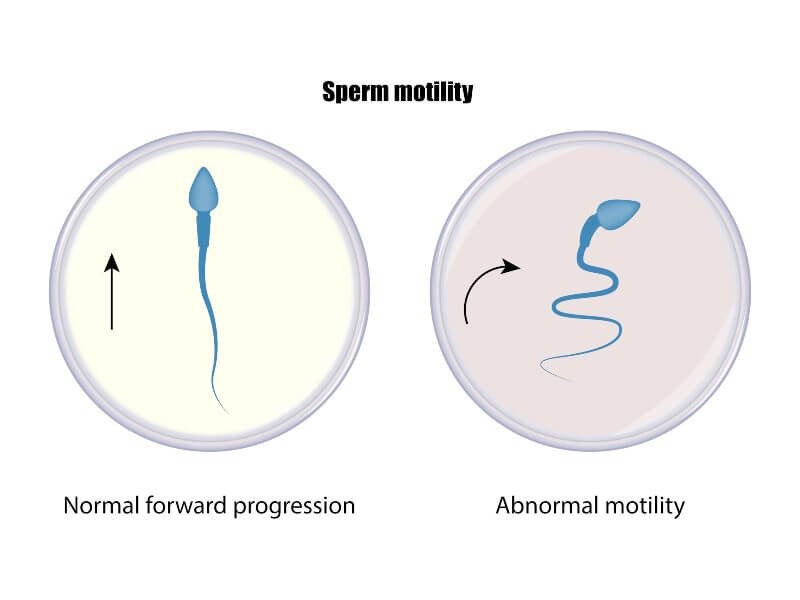Sperm motility is important for fertility because sperm cells need to move through a woman's reproductive system to reach and fertilize the oocyte (egg). Poor sperm movement is the cause of male infertility in 40 percent of men with motility issues.
Sperm motility types
The normal sperm motility range is measured in a percentage of motile sperms held against the total sperm cells seen per ml.
Motility consists of two types:
Progressive motility
Sperms that swim and move forward in a straight line or in the form of closed large circles. These movements occur at 25 micrometers per second.
Non-Progressive Motility
Sperms move in place in very narrow circles at a speed of 5 micrometers per second.

Sperm motility normal range
The normal range for sperm motility, including sperms that move in progressive and non-progressive movement, is about 40-81%. As for progressive movement, the proportion of sperm movement in men is normally about 32-75%.
Causes of low sperm motility
The causes of poor sperm motility vary, but common causes are those that affect the testicles, including:
- Infection of testicles or testicular area.
- Testicular cancer.
- Complications of testicular surgery.
- Genetic factor.
- Undescended testicle.
- The use of steroids for a long time can reduce sperm movement.
- Certain medicines.
- Varicocele.
How to increase sperm motility?
If a man wonders whether his sperm motility rate is normal, a semen analysis can be done. The motility (sperm movement) will be determined by a percentage of the total sperms counted per ml. The higher the sperm count and percentage of motility the higher the chances of pregnancy when sexual intercourse occurs during the female’s fertile period.
Some lifestyle changes can increase sperm motility and quality
- Avoid smoking; smoking can reduce fertility and has been shown to affect sperm movement.
- Stay away from sexual steroids that lead to poor sperm motility
- Avoid excessive drinking of alcohol.
- Take supplements; certain supplements can increase sperm movement, consult with your doctor about which would be the best to take.
- There is a link between increased scrotum temperature and low sperm quality; wear wide comfortable clothes, preferably cotton. If due to profession or your hobby you are required to sit for long periods of time, try to get up and stretch every 2 hours to avoid temperatures rising in the scrotal area.
how to increase sperm motility naturally?
1- Eat healthy food
Maintaining a healthy diet; reducing fat and sugar intake, consume vegetables and fruits containing vitamins, antioxidants and fibers. This can improve sperm movement and overall sexual health.
2- Avoid smoking
Smoking has a direct harmful effect on sexual health and the quality of sperms.
3- Maintaining a healthy BMI
Maintaining a healthy Body Mass Index (BMI) has a positive effect on overall health including the sexual reproductive systems of both men and women.
4- Exercising
Regular exercise has a positive effect on overall health including the sexual reproductive systems in both men and women.
How to get pregnant with Poor Sperm motility?
Normal sperm motility to get pregnant is an important factor. For pregnancy to occur sperm count, sperm movement and morphology should all be in normal ranges. This does not however mean if they are not in normal ranges that pregnancy cannot occur the normal way it can but might take longer. It is however better to treat these factors if any of them deviates from normal.
There are certain medicines that can improve sperm movement and if these do not have the desired effect methods of Artificial Reproductive Technology (ART) can be considered.
Intrauterine insemination (IUI)
In the IUI technique a sperm sample is collected from the male partner and processed in the laboratory. It is then injected via a catheter into the uterine cavity of the female partner on her most fertile days. These days are determined through ultrasound and can be done naturally or after giving her ovulation stimulating medication.
In vitro fertilization method (IVF)
During an IVF process the oocytes (eggs) are extracted from the female partner and put together in a test tube with the processed semen of the male partner for fertilization. After fertilization the embryos are put into petri dishes in incubators until they have developed enough for transfer back into the female uterus usually this happens on day 3-5 after the ovum pickup (egg pickup).
Intracytoplasmic Sperm Injection (ICSI)
Intracytoplasmic Sperm Injection (ICSI) is a technique where a single spermatozoa (sperm cell) is injected directly into the oocyte (egg). This procedure is done in cases of extremely poor-quality sperm or after a testicular biopsy when there are no spermatozoa in semen.











